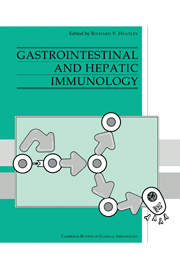Book contents
- Frontmatter
- Contents
- List of contributors
- Preface
- 1 Lymphoid cells and tissues of the gastrointestinal tract
- 2 Lymphocyte migration to the gut mucosa
- 3 Regulating factors affecting gut mucosal defence
- 4 Gastritis
- 5 The immunology of coeliac disease
- 6 Inflammatory bowel disease
- 7 Food intolerance and allergy
- 8 Gastrointestinal and liver involvement in primary immunodeficiency
- 9 Secondary immunodeficiency – the acquired immunodeficiency syndrome (AIDS)
- 10 Intestinal infections
- 11 Lymphomas
- 12 Small bowel transplantation
- 13 Clinical aspects of immunologically mediated intestinal diseases
- 14 Chronic active hepatitis
- 15 Primary biliary cirrhosis
- 16 Immunology and immunopathology of acute viral hepatitis
- 17 Immunology of liver transplantation
- 18 Clinical correlates with hepatic diseases
- Index
13 - Clinical aspects of immunologically mediated intestinal diseases
Published online by Cambridge University Press: 03 February 2010
- Frontmatter
- Contents
- List of contributors
- Preface
- 1 Lymphoid cells and tissues of the gastrointestinal tract
- 2 Lymphocyte migration to the gut mucosa
- 3 Regulating factors affecting gut mucosal defence
- 4 Gastritis
- 5 The immunology of coeliac disease
- 6 Inflammatory bowel disease
- 7 Food intolerance and allergy
- 8 Gastrointestinal and liver involvement in primary immunodeficiency
- 9 Secondary immunodeficiency – the acquired immunodeficiency syndrome (AIDS)
- 10 Intestinal infections
- 11 Lymphomas
- 12 Small bowel transplantation
- 13 Clinical aspects of immunologically mediated intestinal diseases
- 14 Chronic active hepatitis
- 15 Primary biliary cirrhosis
- 16 Immunology and immunopathology of acute viral hepatitis
- 17 Immunology of liver transplantation
- 18 Clinical correlates with hepatic diseases
- Index
Summary
Introduction
It will be readily apparent from the preceding chapters that there have been enormous advances in recent years in our understanding of the immunopathology of the gut. This chapter examines the impact which such advances have made in the clinical management of patients with immunologically mediated intestinal disease. In view of the potential size and complexity of this field the discussion has been necessarily restricted, but it is hoped that the examples covered will serve to illustrate important underlying concepts. The first section of this chapter will deal with selected clinical manifestations of various diseases and the role of immunological processes in their pathophysiology, diagnosis and assessment. This will be followed by an overview of immunomodulatory therapy in current use as well as prospects for the future.
Clinical manifestations, diagnosis and assessment
When the host immune response to antigen is inappropriate or exaggerated and leads to tissue damage, hypersensitivity is said to exist. This is a feature common to many of the diseases considered in this volume. Various aspects of these disorders will now be examined in terms of hypersensitivity according to the four part classification originally proposed by Coombs and Gell in 1963. In this way, certain characteristic clinical features of different intestinal diseases can be related to underlying immune processes. In addition, the role of immunological markers will be considered with respect to diagnosis and disease assessment.
Type I reactions
Type I, or immediate, hypersensitivity arises as a consequence of the interaction of allergen with specific mast cell-bound IgE. Subsequent degranulation leads to the release of various inflammatory mediators including histamine and kinins.
- Type
- Chapter
- Information
- Gastrointestinal and Hepatic Immunology , pp. 247 - 268Publisher: Cambridge University PressPrint publication year: 1994



